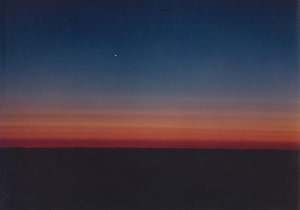Atmospheric scientists gear up for collaborative airborne campaigns
Atmospheric scientists gear up for collaborative airborne campaigns
Submitted by Amy Hartley
Phone: 907-474-5823
04/10/08

Download photo
During the mid-1970s, Glenn Shaw of the Geophysical Institute at the University of Alaska Fairbanks stumbled upon the notion of Arctic haze after collecting aerosol samples from Barrow, Alaska. At that time, many believed the Arctic to contain relatively pure air due to its remote locale and minimal population. However, the concept was rocked once Shaw’s data indicated there was a murky cloud of pollution that hovered above the Arctic during winter and spring. Now, more than 30 years later, the grey-blue hue of Arctic haze is a well-known phenomenon of the north. It’s a mixture of industrial pollution and it does not originate in the Arctic, but migrates there aboard air currents that pass over the Far East and Eurasia.
Better understanding of Arctic haze is just one aim of concurrent airborne campaigns that have begun in Fairbanks. Partnering hundreds of scientists from UAF, the National Aeronautics and Space Administration, the National Oceanic and Atmospheric Administration and the Department of Energy, the campaigns are designed to collect data on the Arctic’s current atmospheric condition. Each of the aircraft used for these missions are outfitted with numerous instruments to detect and obtain samples of atmospheric components.
Shaw will manage the UAF efforts to support the NASA campaign dubbed ARCTAS--the Arctic Research of the Composition of the Troposphere from Aircraft and Satellites. For this program, UAF representatives will collect and analyze aerosol samples from the ground, and advise NASA pilots on current meteorological conditions that will affect flight schedules for three aircraft.
Bill Simpson, an associate professor of environmental chemistry with the Geophysical Institute, and graduate student Dan Carlson will aid the NOAA campaign titled Aerosol, Radiation, and Cloud Processes affecting Arctic Climate Change, or simply ARCPAC. The two will analyze the measurements of halogen oxides, reactive chemicals produced from sea ice, in Barrow. Halogen oxides are affiliated with the destruction of ozone and deposition of mercury in the Arctic region, and are likely to respond to recent changes in sea ice extent and thickness.
Martin Stuefer, a research associate with the Geophysical Institute, will support the DOE project titled Indirect and Semi-Direct Aerosol Campaign. Stuefer will monitor instrument performance at a DOE laboratory in Barrow, and provide weather briefings for ISDAC flights from Fairbanks.
MEDIA ADVISORY:
A one-hour briefing on ARCTAS, ARCPAC, and ISDAC will take place April 14, 2008. The
event will begin at 10 a.m. AST in the Globe Room at the Geophysical Institute, UAF.
Escorted visits to the multiple aircraft will be arranged following the briefing at
the Fairbanks International Airport. Due to space limitations and security concerns,
media must confirm their attendance in advance by calling 907-474-5823.
CONTACT:
Amy Hartley, Geophysical Institute Information Officer: 907-474-5823.


